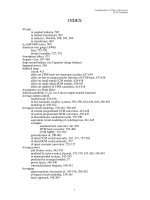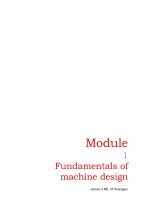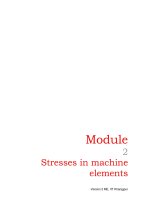Tài liệu Fundamentals Of Power Electronics P2 pptx
Bạn đang xem bản rút gọn của tài liệu. Xem và tải ngay bản đầy đủ của tài liệu tại đây (99.94 KB, 20 trang )
Fundamentals of Power Electronics
R. W. Erickson
1
INDEX
Air gap
in coupled inductor, 502
in flyback transformer, 503
in inductor, 464-466, 498, 505, 509
in transformer, 469
A
L
(mH/1000 turns), 509
American wire gauge (AWG)
data, 755-756
design examples, 527, 531
Amorphous alloys, 473
AmpereÕs law, 457-458
Amp-second balance (see Capacitor charge balance)
Apparent power, 550
Artificial ramp
circuit, 415
effect on CPM boost low-harmonic rectifier, 637-639
effect on line-to-output transfer function of CCM buck, 437-438
effect on small-signal CCM models, 428-438
effect on small-signal DCM models, 438-447
effect on stability of CPM controllers, 414-418
Asymptotes (see Bode plots)
Audiosusceptibility G
vg
(s) (see Line-to-output transfer function)
Average current control
feedforward, 635-636
in low-harmonic rectifier systems, 593-598, 634-636, 649, 650-652
modeling of, 649-652
Averaged switch modeling, 239-245, 390-403
of current-programmed CCM converters, 423-428
of current-programmed DCM converters, 438-447
in discontinuous conduction mode, 370-390
equivalent circuit modeling of switching loss, 241-245
examples
nonideal buck converter, 241-245
DCM buck converter, 393-400
CCM SEPIC, 757-762
generalization of, 390-403
of ideal CCM switch networks, 242, 377, 757-762
of ideal DCM switch networks, 377
of quasi-resonant converters, 732-737
Average power
and Fourier series, 542-543
modeled by power source element, 375-379, 423-428, 438-447
in nonsinusoidal systems, 542-555
predicted by averaged models, 57
power factor, 546-550
sinusoidal phasor diagram, 550-551
Averaging
approximation, discussion of, 195-196, 200-202
averaged switch modeling, 239-245
basic approach, 198-209
Fundamentals of Power Electronics
R. W. Erickson
2
capacitor charge balance, 24
circuit, 231-245
to find dc component, 6, 16
flyback ac model, 209-218
inductor volt-second balance, 22-23
introduction to, 193-198
modeling efficiency and loss via, 57
to model rectifier output, 645-647
to model 3¿ converters, 611-614
of quasi-resonant converters
ac modeling, 732-737
dc analysis, 712-728
state-space, 218-231
Battery charger, 9, 70
B-H loop
in an ac inductor, 499-500
in a conventional transformer, 153, 500-501
in a coupled inductor, 501-502
in a filter inductor, 497-499
in a flyback transformer, 502-503
modeling of, 458-460
Bidirectional dc-dc converters, 70
Bipolar junction transistor (BJT)
breakdown mechanisms in, 86-87
construction and operation of, 82-87
current crowding, 85-86
Darlington-connected, 87
idealized switch characteristics, 65-66
on resistance, 53, 82
quasi-saturation, 82-83, 86
storage time, 84
stored minority charge in, 82-86
switching waveforms, 83-86
Bode plots (see also Harmonic trap filters, sinusoidal approximation)
asymptote analytical equations, 275-276
CCM buck-boost example, 289-292
combinations, 272-276
complex poles, 276-282
frequency inversion, 271-272
graphical construction of, 296-309
addition, 296-301
closed-loop transfer functions, 329-332
division, 307-309
parallel combination, 301-307
parallel resonance, 301-303
series resonance, 298-303
impedance graph paper, 307
nonminimum phase zero, 269-271
reactance graph paper, 307
real pole, 263-268
real zero, 268-269
RHP zero, 269-271
transfer functions of buck, boost, buck-boost, 292-293
Body diode (see MOSFET)
Fundamentals of Power Electronics
R. W. Erickson
3
Boost converter (see also Bridge configuration, Push-pull isolated converters)
active switch utilization in, 179, 608
averaged switch model, DCM, 380-381
circuit-averaged model, 233-239
current-programmed
averaged switch model, CCM, 424-425
averaged switch model, DCM, 443-444
small-signal ac model, CCM, 427-428, 430-431
small-signal ac model, DCM, 445-447
as inverted buck converter, 136-137
as low-harmonic rectifier, 594-597, 605-609, 617, 627-634
nonideal analysis of, 43-51, 53-57
quasi-resonant ZCS, 722-723
small-signal ac model
CCM, 208-210, 251
DCM, 385-390
steady-state analysis of,
CCM, 24-29
DCM, 121-125
transfer functions, CCM, 292-293
Bridge configuration (dc-dc converters)
boost-derived full bridge, 171-172
buck-derived full bridge, 154-157
buck-derived half bridge, 157-159
full bridge transformer design example, 528-531
minimization of transformer copper loss in, 516-517
Bridge configuration (inverters)
single phase, 7-8, 142-145, 148-150
three phase, 70, 143-148
Buck-boost converter (see also Flyback converter)
3¿ac-dc rectifier, 615-616, 619
averaged switch model, DCM, 370-381
as cascaded buck and boost converters, 138-141
current-programmed
averaged switch model, DCM, 438-444
more accurate model, CCM, 430-432
simple model, CCM, 419-423
small-signal ac model, DCM, 445-447
dc-3¿ac inverter, 71-72, 615-616
DCM characteristics, 115, 127-129, 381
as low-harmonic rectifier, 598-599
manipulation of ac model into canonical form, 248-251
nonideal, state-space averaged model of, 227-232
noninverting version, 139, 148-149
as rotated three-terminal cell, 141-142
small-signal ac model, CCM, 208-210, 251
small-signal ac model, DCM, 382-388
transfer functions, CCM, 289-293
transformer isolation in, 166-171
Buck converter (see also Bridge configuration, Forward converter, Push-pull isolated
converters), 6, 15-23, 34-35
active switch utilization in, 179
averaged switch model, 239-245
current-programmed
Fundamentals of Power Electronics
R. W. Erickson
4
averaged switch model, CCM, 423-427
averaged switch model, DCM, 442-447
small-signal ac model, CCM, 421-427, 431-438
small-signal ac model, DCM, 442-447
equivalent circuit modeling of,
small-signal ac, CCM, 208-210, 251
small-signal ac, DCM, 385-388, 393-400
steady-state, CCM, 51-53
steady-state, DCM, 380-381
as high power factor rectifier
single phase, 599
three phase, 614-615
multi-resonant realization, 729
quasi-square-wave resonant realizations, 730-731
quasi-resonant realizations
ac modeling of, 732-737
zero current switching, 662-663, 712-722, 723-724
zero voltage switching, 728
small-signal ac model
CCM, 208-210, 251
DCM, 385-390
steady-state analysis of,
CCM, 17-22, 23, 34-35, 51-53
DCM, 111-121, 380-381
switching loss in, 94-101, 241-245
employing synchronous rectifier, 73-74
transfer functions, CCM, 292-293
Buck
2
converter, 149, 151
Buck 3¿ inverter (see Voltage source inverter)
Canonical circuit model, 245-251
via generalized switch averaging, 402-403
manipulation into canonical form, 248-251
parameters for buck, boost, buck-boost, 251
physical development of, 245-248
transfer functions predicted by, 247-248, 292-293
Capacitor amp-second balance (see Capacitor charge balance)
Capacitor charge balance
boost converter example, 27
Cuk converter example, 31-32
definition, 24
in discontinuous conduction mode, 115
nonideal boost converter examples, 45, 55
Capacitor voltage ripple
boost converter example, 28-29
buck converter example, 34-35
in converters containing two-pole filters, 34-35
Cuk converter example, 32-34
Cascade connection of converters, 138-141
Characteristic value a (current programmed mode), 414, 417-418, 435-436
Charge balance (see Capacitor charge balance)
Circuit averaging (see also Averaged switch modeling), 231-245
averaging step, 235
boost converter example, 233-238
Fundamentals of Power Electronics
R. W. Erickson
5
linearization, 235-238
obtaining a time-invariant network, 234-235
summary of, 231-233
Commutation
failure, 574
notching, 575
in 3¿ phase controlled rectifier, 573-575
Compensators (see also Control system design)
design example, 346-354
lag, 343-345
lead, 340-340, 350-351
PD, 340-343, 350-351
PI, 343-345
PID, 345-346, 352-354
Complex power, 550-551
Computer power supply, 8-9
Computer spreadsheet, design using, 180-183
Conduction loss (see Copper loss, Semiconductor conduction loss)
Conductivity modulation, 75, 79, 82, 87, 90
Control system design (see also Compensators, Negative feedback), 323-368
compensation, 340-346
construction of closed-loop transfer functions, 326-332
design example, 346-354
for low-harmonic rectifiers
approaches, 634-652
modeling, 645-652
phase margin
test, 333-334
vs. closed-loop damping factor, 334-338
stability, 332-339
voltage regulator
block diagram, 324-325, 328, 347-349
design specifications, 339-340
Control-to-output transfer function
as predicted by canonical model, 248
of CCM buck, boost, and buck-boost converters, 292-293
of current programmed converters, 422, 427-428, 434-437, 446
of DCM converters, 387-390, 396-399
of quasi-resonant converters, 733, 736
Conversion ratio M (see also Switch conversion ratio m)
of boost, 18, 26, 127, 381
of buck, 18, 120, 381
of buck-boost, 18, 128, 381
of Cuk converter, 32, 381
of loss-free resistor networks, 376-381
in low-harmonic rectifiers, 593-595
modeling of, 40-43
of quasi-resonant converters, 711, 720-723
of parallel resonant converter, 676-678, 686-689
of SEPIC, 151, 381
of series resonant converter, 671-674, 679-686
via sinusoidal approximation, 670
Copper loss
Fundamentals of Power Electronics
R. W. Erickson
6
allocation of window area to minimize, 513-517, 519
high frequency effects
skin effect, 475-476
proximity effect, 476-490
inductor design to meet specified, 503-509
low frequency, 474
modeling in converters, 43-53
Core loss, 471-474, 518
Coupled inductors
in Cuk converter, 494-495, 501
in multiple-output buck-derived converters, 501-502, 511
Crossover frequency, 330-334
Cuk converter
3¿ac-dc converter, 615-616
active switch utilization of, 179
as cascaded boost and buck converters, 141
conversion ratio M(D), 32, 381
DCM averaged switch model of, 379-381
as low-harmonic rectifier, 597-599, 608
as rotated three-terminal cell, 141-142
steady-state analysis of, 29-34
transformer design example, 524-528
with transformer isolation, 176-177
Current-fed bridge, 148, 150
Current injection, 359-360
Current programmed control, 408-451
ac modeling of
via averaged switch modeling, CCM, 423-428
via averaged switch modeling, DCM, 438-447
CCM more accurate model, 428-438
CCM simple approximation, 418-428
artificial ramp, 414-418
controller circuit, 409, 415
controller small-signal block diagram, 428-432
in half-bridge buck converters, 159, 410
in low harmonic rectifiers, 636-639
oscillation for D > 0.5, 411-418
in push-pull buck converters, 166, 410
Current ripple (see inductor current ripple)
Current sense circuit, isolated, 187-188
Current source inverter (CSI), 146, 148
Cycloconverter, 1, 72
Damping factor z (see also Q-factor), 277
Dc conversion ratio (see Conversion ratio M)
Dc link, 10
Dc transformer model
in averaged switch models, 237-244, 760-762
in canonical model, 245-247, 250-251
in circuit averaged models, 237-238
comparison with DCM model, 377
derivation of, 40-43
equivalence with dependent sources, 41
manipulation of circuits containing, 41-42, 48-49
Fundamentals of Power Electronics
R. W. Erickson
7
in a nonideal boost converter, 48-49, 56
in a nonideal buck converter, 52-53
in small-signal ac CCM models, 208-210
Decibel, 262
Delta-wye transformer connection, 582-583
Dependent power source (see Power source element)
Derating factor, 180
Design-oriented analysis, techniques of
analytical expressions for asymptotes, 275-276
approximate factorization, 285-288
doing algebra on the graph, 296-309
frequency inversion, 271-272
graphical construction
of Bode plots, 296-309
of closed-loop transfer functions, 329-332
low Q approximation, 282-284
philosophy of, 261, 306-307
Differential connection of load
polyphase inverter, 143-148
single-phase inverter, 142-143
Diode
antiparallel, 67
characteristics of, 78
fast recovery, 77
forward voltage drop (see also Semiconductor conduction losses), 53-57, 77
freewheeling, 67
parallel operation of, 77-78
recovered charge Q
r
, 76, 97-100, 692, 729
recovery mechanisms, 76-77, 98-100
Schottky, 74, 77, 101
soft recovery, 98-99
snubbing of, 99
switching loss, 97-100, 101-103, 692
switching waveforms, 75-77, 98-100, 101-102
zero current switching of, 101-103, 690-692, 696, 725-726
zero voltage switching of, 692-696, 725-726, 729, 734
Discontinuous conduction mode (DCM)
B-H loop, effect on, 503-504
boost converter example, 121-127
buck converter example, 111-121
buck-boost converter example, 370-381
in current programmed converters, 438-447
equivalent circuit modeling of, 369-381, 438-444
in forward converter, 159
in line-commutated rectifiers, 564-568, 569-570
in low-harmonic rectifiers
boost rectifier, single phase, 594-597
single-switch, three-phase, 615-619
mode boundary
in boost rectifier, 594-697
vs. K, 111-115, 121-122, 128
vs. load current and R
e
, 381
origin of, 111-115
in parallel resonant converter, 687-689
Fundamentals of Power Electronics
R. W. Erickson
8
in PWM converters, 110-134, 369-407, 438-447
in series resonant converter, 681-683
small-signal ac modeling of, 382-403
Displacement factor, 548, 550-551
Distortion factor (see also Total harmonic distortion), 548-550
of single-phase rectifier, 548, 563-566
Distributed power system, 9
Doing algebra on the graph (see Graphical construction of Bode plots)
Duty ratio
complement of, 16
definition of, 15-16
EC core data, 754
Eddy currents
in magnetic cores, 472
in winding conductors, 474-477
EE core data, 753
Effective resistance R
e
in DCM averaged switch model, 374-381
in loss-free resistor model, 374-381
in resonant converter models
with capacitive filter network, 666-668
with inductive filter network, 674-676
Emulated resistance R
e
, 590-593
Efficiency, 2
averaged switch modeling, predicted by, 245
of boost converter
as low-harmonic rectifier, 632-634
nonideal dc-dc, 49-51, 56
calculation via averaged model, 49-51, 56
vs. switching frequency, 103-104
Equivalent circuit modeling
by canonical circuit model, 245-251
of CCM converters operating in steady-state, 40-61
of converters having pulsating input currents, 51-53
of current programmed switch networks
CCM, 423-428
DCM, 438-447
small-signal models, 421-422, 423-428, 445-447
of flyback converter, CCM, 168, 216-218
of ideal rectifiers, 590-593, 608-611
of ideal dc-dc converters, 40-42
of inductor copper loss, 43-51
small-signal models
CCM, 207-209, 230-232
DCM, 382-390
current programmed, 421-422, 424-428, 438-447
of switching loss, 241-245
of switch networks
CCM, 239-242
DCM, 370-381
of systems containing ideal rectifiers, 602
Equilibrium (see Steady state)
Equivalent series resistance (esr) of capacitor, 554-555
ETD core data, 754









